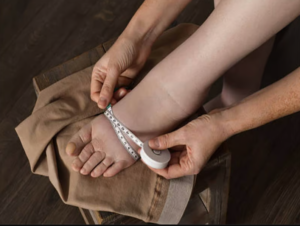Lymphedema is a chronic condition that can significantly impact a person’s quality of life. While often associated with visible swelling, its effects extend beyond just the affected limb, influencing posture and overall body mechanics. This article examines the complex relationship between lymphedema and posture, delving into the underlying mechanisms and providing practical strategies for management and improvement.
What is Lymphedema?
Lymphedema is a condition characterised by swelling, typically in the arms and legs, caused by a blockage in the lymphatic system. The lymphatic system, a crucial part of the immune and circulatory systems, is responsible for collecting lymph fluid and returning it to the bloodstream. When this system is compromised, lymph fluid accumulates, leading to persistent swelling and discomfort, directly contributing to poor posture.
Causes and Risk Factors
Lymphedema can arise from various causes, most commonly as a result of lymph node damage or removal during cancer treatment, particularly breast cancer surgery. Other risk factors include genetic conditions, infections, and trauma that disrupt the normal function of the lymphatic system. Understanding these risk factors is crucial for early detection and intervention, helping to manage lymphedema and mitigate its impact on posture.
Symptoms and Impact on Posture
The primary symptom of lymphedema is swelling in the affected area, which can range from mild to severe. This swelling can lead to feelings of heaviness, tightness, and restricted movement. Over time, the altered weight distribution and discomfort can significantly impact posture, often causing individuals to lean or compensate in ways that exacerbate musculoskeletal issues. People with lymphedema may develop poor posture as they try to alleviate discomfort from the swollen area.
The Role of the Lymphatic System
How Lymphatic Drainage Works
Lymphatic drainage is the process by which the lymphatic system removes waste, toxins, and excess fluid from the body’s tissues. Lymph vessels transport lymph fluid, which contains immune cells and proteins, through a network of lymph nodes that filter and cleanse the fluid. Proper lymphatic drainage is essential for maintaining fluid balance, immune function, and overall health; its disruption directly contributes to lymphedema and related postural problems.
The Importance of Lymph in Body Function
Lymph plays a vital role in maintaining fluid balance, transporting immune cells, and removing waste products from tissues. The lymphatic system helps defend the body against infection and disease. Without proper lymph function, fluid can accumulate in the tissues, leading to lymphedema and potentially impacting posture and movement. The lymphatic system’s role is integral to understanding the impact of its dysfunction.
Physical Activity and the Lymphatic System
Physical activity is crucial for stimulating lymphatic drainage. Muscle contractions help move lymph fluid through the lymph vessels. Regular exercise, including targeted activities like deep breathing exercises and specific arm or leg movements, can improve lymphatic flow and reduce swelling. An exercise program can be designed to help move lymph fluid and improve posture. Physical activity is an important aspect of managing lymphedema.
Posture Challenges in People with Lymphedema
Effects on Head and Neck Alignment
Lymphedema can significantly impact head and neck alignment, especially after breast cancer treatment when lymph nodes are removed or damaged. The resultant swelling in the upper body can cause people with lymphedema to adopt compensatory postures, leading to muscle imbalances and discomfort. This may manifest as a forward head posture or a tilted neck, further exacerbating the condition and affecting posture.
Understanding Standing Lymphedema
Standing lymphedema refers to the swelling that occurs primarily in the legs and feet due to impaired lymphatic drainage. This condition can make it challenging to maintain proper posture while standing, as the legs feel heavy and uncomfortable. People with lymphedema may shift their weight unevenly, leading to postural imbalances and potentially causing pain in the back, hips, and knees. Managing lymphedema effectively is essential to improve standing posture.
How Swelling Affects Body Mechanics
Swelling caused by lymphedema disrupts normal body mechanics by altering weight distribution and limiting joint movement. As lymph fluid accumulates in the tissues, it creates additional mass that the body must compensate for. This can lead to altered gait patterns, reduced range of motion, and increased strain on muscles and joints. Addressing swelling is a crucial component of restoring proper body mechanics and improving posture.
Improving Posture Through Breathing Exercises
Benefits of Deep Breathing for Lymphedema
Deep breathing exercises offer multiple benefits for people with lymphedema. Deep breathing helps stimulate lymphatic drainage by creating pressure changes in the chest and abdomen, which aids in the movement of lymph fluid through the lymphatic system. Regular deep breathing can reduce swelling, improve circulation, and promote relaxation, all of which contribute to better posture and overall well-being. Such exercises help move lymph fluid.
Effective Deep Breathing Exercises
Several deep breathing exercises can be incorporated into an exercise routine to help manage lymphedema and improve posture. Diaphragmatic breathing, also known as belly breathing, involves inhaling deeply through the nose, allowing the abdomen to expand, and exhaling slowly through the mouth. This type of breathing exercise helps to massage the internal organs and stimulate lymph drainage. Another effective exercise involves lying flat on the floor, practising deep breaths, and ensuring your feet are flat on the floor.
Incorporating Breathing into Daily Routines
Integrating deep breathing exercises into daily routines can be a simple yet effective strategy for managing lymphedema and improving posture. Set aside a few minutes each day to practice deep breathing, whether it’s during your morning routine, at your desk during work, or before bedtime. Combine deep breathing with gentle stretching and movement exercises to further enhance lymphatic drainage and promote good posture. An exercise program can incorporate such breathing techniques.
Compression and Its Effects on Posture
Using Compression Garments Effectively
Compression garments play a crucial role in managing lymphedema and improving posture by providing support and promoting lymphatic drainage. These garments apply consistent pressure to the affected area, which helps move lymph fluid and reduce swelling. For people with lymphedema, wearing compression garments can alleviate discomfort, improve mobility, and support better posture, making them an essential part of a comprehensive exercise routine and management plan.
How Compression Helps with Lymphatic Drainage
Compression aids lymphatic drainage by gently squeezing the tissues and lymph vessels, facilitating the movement of lymph fluid. This external pressure helps to push the fluid through the lymphatic system, preventing it from accumulating and causing swelling. Regular use of compression, whether through compression garments or compression bandages, can significantly improve lymph drainage, reduce lymphedema symptoms, and promote good posture by reducing the burden of excess fluid.
Choosing the Right Compression Solutions
Selecting the right compression solution is crucial for effectively managing lymphedema. Compression garments come in various sizes, styles, and compression levels, so it’s important to consult with a lymphedema specialist or a physical therapist to determine the most appropriate option. Factors to consider include the severity of lymphedema, the location of swelling, and personal preferences. Properly fitted compression garments can provide optimal support and facilitate lymphatic drainage, ultimately contributing to improved posture and quality of life.
Neck and Mouth Exercises for Posture Improvement
Neck Exercises to Alleviate Tension
Neck exercises can effectively alleviate tension and improve posture, especially for people with lymphedema affecting the head and neck area. Simple exercises like neck rotations, side stretches, and chin tucks can help release muscle tightness, improve range of motion, and promote proper alignment. Regular performance of these exercises can reduce discomfort, improve head and neck posture, and enhance lymphatic drainage in the affected area, supporting better overall well-being.
Mouth Exercises to Facilitate Lymphatic Drainage
Mouth exercises can also play a role in facilitating lymphatic drainage and improving posture, particularly for individuals experiencing swelling in the face or neck. These exercises, such as gentle jaw movements, tongue stretches, and facial muscle contractions, can stimulate lymph vessels and promote the flow of lymph fluid. By incorporating mouth exercises into a daily exercise routine, people with lymphedema can reduce swelling, alleviate tension, and support better head and neck alignment, contributing to improved posture.
Integrating Exercises into Daily Life
Integrating neck and mouth exercises into daily life can be a simple yet effective strategy for managing lymphedema and improving posture. Set aside a few minutes each day to perform these exercises, whether it’s during your morning routine, at your desk during work, or before bedtime. Combining these exercises with deep breathing exercises and gentle stretching can further enhance lymphatic drainage and promote good posture. Consistency is key, so make these exercises a regular part of your routine to reap the benefits.
Manual Lymphatic Drainage Techniques
Overview of Manual Lymphatic Drainage
Manual lymphatic drainage (MLD) is a specialised massage technique designed to stimulate lymphatic drainage and reduce swelling in people with lymphedema. Performed by a trained lymphedema therapist, MLD involves gentle, rhythmic movements that follow the natural pathways of the lymphatic system. These movements help move lymph fluid from congested areas to areas with healthy lymph vessels, promoting fluid balance and reducing lymphedema symptoms. MLD can also improve posture by alleviating discomfort and reducing the burden of excess fluid.
When to Seek Professional Help
While some self-care strategies can help manage lymphedema, seeking professional help from a lymphedema therapist or physical therapist is crucial for comprehensive care. A therapist can provide a thorough assessment of your condition, develop a tailored treatment plan, and teach you specific manual lymphatic drainage techniques to use at home. It’s particularly important to seek professional help if you experience severe swelling, skin changes, or other concerning lymphedema symptoms. Early intervention can help prevent complications and improve long-term outcomes.
DIY Techniques for Home Use
In addition to professional treatment, there are several DIY techniques that people with lymphedema can use at home to support lymphatic drainage. These techniques include simple self-massage, deep breathing exercises, and gentle range-of-motion exercises. Self-massage involves using light, rhythmic strokes to move lymph fluid towards healthy lymph nodes. Combining these techniques with compression garments and regular physical activity can further enhance lymphatic drainage and promote good posture. Remember to consult with your lymphedema therapist before starting any new self-care techniques to ensure they are appropriate for your specific condition.
Key Takeaways on Posture and Lymphedema
In summary, understanding the relationship between lymphedema and posture is vital for effective management. Lymphedema, characterised by swelling due to impaired lymphatic drainage, can significantly affect posture. Effective strategies such as deep breathing exercises, the use of compression garments, and specific exercises can help move lymph fluid and alleviate discomfort. Managing lymphedema is essential for maintaining good posture and overall well-being. The lymphatic system is crucial for overall health.
Final Advice for Managing Lymphedema
For those managing lymphedema, consistency is key. Incorporate deep breathing into your daily routine to support lymphatic drainage. Use compression, whether through a compression garment or compression bandages, to manage swelling. Consult with a physical therapist or lymphedema specialist to tailor an exercise program that suits your needs. Regular physical activity, combined with targeted exercises, can significantly improve your posture and quality of life. Addressing lymphedema symptoms promptly is paramount.
Encouragement for Physical Activity
Stay active! Physical activity is a powerful tool in the fight against lymphedema. Simple activities like walking, swimming, or cycling can stimulate lymph flow and reduce swelling. Remember to listen to your body and avoid overexertion. Even small amounts of exercise can make a big difference in managing lymphedema and improving your posture. Embrace physical activity as a means to empower yourself and take control of your health. Embrace moving lymph fluid through your limbs and enjoy the benefits.
FAQs
1. Can lymphedema affect posture?
Yes. Swelling and heaviness from lymphedema can alter body mechanics, causing poor alignment and postural imbalances.
2. How does swelling from lymphedema impact movement?
Excess fluid adds weight and restricts joint motion, often leading to uneven weight distribution, discomfort, and gait changes.
3. What exercises help improve posture with lymphedema?
Deep breathing, gentle stretching, neck and mouth exercises, and light physical activity support lymph drainage and better posture.
4. Do compression garments improve posture in lymphedema patients?
Yes. Compression garments reduce swelling, relieve heaviness, and provide external support that helps maintain proper posture.
5. When should someone with lymphedema seek professional help?
If swelling worsens, skin changes, or pain increases, consulting a lymphedema therapist or physical therapist is essential.





